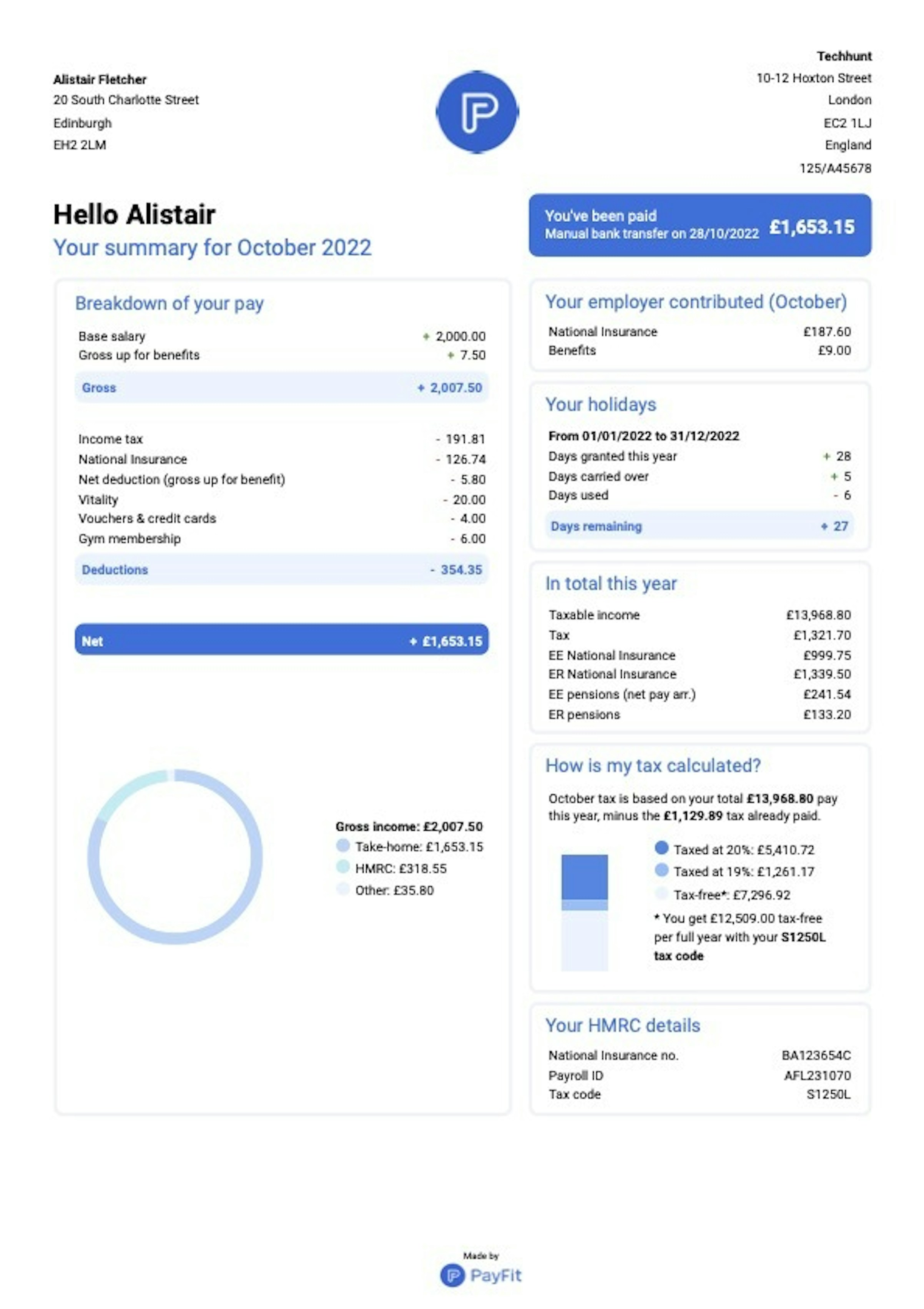What's on Your Payslip? Your Payslip Explained

Ah, payday! I mean, what's not to like about it?
Payslips get sent out, bank accounts get a hearty refill, and we can all go out and put our hard-earned money to work - whether that’s making sure our bills are covered, saving up for a rainy day, or spending it.
However, do any of us really take the time to think about what’s printed on our payslips?
We get it: They’re a tad confusing. Especially with all those funny-looking symbols and mysterious-looking deductions that can make you go: ‘I swear I never used to pay that much tax!’.
Indeed, there’s an anatomy to what’s on a payslip, and we’ll going to use this post to break this down.
If you’re an employer:
This resource is still super relevant, especially if you’re fielding tons of questions from head-scratching employees. We’ll also touch on how to go from a paper-based to an online payslip setup. So without further ado, this is payslips explained.
But first, what’s the purpose of a payslip?
A payslip is a document an employee gets every payday, showing their total earnings less any deductions, including tax.
It’s important as an employee to keep your payslips safe for three key reasons:
It’s your data. Payslips include lots of personal details such as your income and National Insurance number. They can even show your address and contact information. So it’s vital that you keep them safe and secure so you don’t fall prey to identity theft.
It’s a record. Payslips are a record of your earnings and employment history. They’re also a record of how much tax you’ve paid, which can be important if you need to refer back to this.
It’s evidence of your earnings. Finally, payslips are often used as proof of earnings for things like mortgage applications and loan requests.
Top 5 pieces of information on payslips
Right, so let’s clear up some of this confusion - shall we? What should appear on your payslip?
Every pay cycle, your payslip contains these five key bits of information. They are:
1. Your gross pay — This is the amount paid before any net deductions but after any salary sacrifice.
2. Your net pay — In other words, the amount of money you’ll receive once all deductions are subtracted. This is what’s known as your take-home pay.
3. Deductions — You should also see the total amount of deductions taken. Remember, these may vary from payday to payday. That’s why they are known as variable deductions and include things like tax, National Insurance and pension contributions.
Within deductions, there may also be a section titled fixed deductions. These deductions are fixed and don’t ever change from payday to payday - for example, union fees. However, they do not have to be shown separately on your payslip if your employer provides a separate statement with these deductions once a year.
4. Payment method — Put simply, how the money is being paid - There are several ways an organisation can pay their employees, from good old-fashioned cash or cheques to more modern-day bank transfers.
PayFit Top Tip:
If you’re an employer, then you can use a couple of tools to make employee payments easier, like Telleroo and FasterPayments.
5. Hours worked — If you’re paid hourly, your payslip must also show how many hours you've worked to receive the sum stated on the payslip. However, if you receive an annual salary, you will not see this on your payslip except when you work overtime.
5 UK Payslip Abbreviations you should know about
In addition to the above, here are a few payslip abbreviations you’d usually find on a UK payslip and what they mean.
BACS - Bankers Automated Clearing Services -A scheme for processing financial transactions
CHB - Child Benefit -An allowance for parents with children under 16
ET - Earnings Threshold -The amount you get before paying any tax
PILON - Payment in Lieu of Notice - Compensation payment for a notice period to do with termination or a request not to work
LEL - Lower Earnings Limit - The amount you get before paying National Insurance
What else can you find on a payslip?
In addition to the core information above, you might find a few other things listed on your payslips. Some of these things your employer may display, others they may not; every company is different, but we’ve tried to break down as many of these elements as we can.
Personal information
Details such as your personal name and home address may be shown.
Payroll number
So could a payroll number, if your company uses that sort of method.
Payment date
The date on which the money is due in your account is often shown too.
Tax information
Including the tax period and your personal tax code is frequently present on payslips, as is your National Insurance (NI) number.
Student loan repayments
Information relating to student loan repayments can be present on payslips. In addition, HMRC usually informs employers how to work out and deduct the correct amount from pay.
Child Maintenance
The Child Maintenance Service (CMS) can also request a Deduction from Earnings Orders (DEOs) for the maintenance of a child. If these orders are made as deductions, employers are permitted to charge a £1 administration fee; however, the charge can only be made if a deduction or partial deduction is actually made.
Court orders
These can also be included too. These deductions come directly from your pay and are generally due to unpaid fines or debt repayments due to creditors. Court orders are also liable to a £1 administration fee.
Sick pay
This is another variable that is often present on payslips. Typically, sick pay depends on how much time you have off, as well as the company’s sick leave policy. All employers must pay Statutory Sick Pay (SSP) if you’re absent from work for four or more days in a row.
Depending on your contract, you may also be entitled to occupational sick pay.
Maternity, paternity and adoption pay
Now this is a big issue in many companies. If you’re a mother and are off because you’ve just given birth, you will receive Statutory Maternity Pay (SMP). This will be present on your payslip. You may also receive maternity pay; however, this will likely to be shown separately. Paternity pay works in much the same way.
Health insurance
If your company provides health insurance or meal vouchers, these may be listed on your payslip and are also likely to affect your tax code. Season ticket loans or other travel schemes, such as cycle to work, may also be displayed.
Year-to-date summary
A year-to-date summary of your earnings may also be visible. If so, it will likely show how much tax, National Insurance contributions (NICs), student loans and pension contributions have been paid.
My payslip is late - what do I do?
If you’ve not received your payslip for a certain pay cycle, you’ll want to bring this up with your manager or HR team as soon as possible. If they don’t resolve this for you, you are within your right to raise a formal complaint.
For employers, your employees must get their payslips on time, every time. Late payslips and delayed payments not only lead to complaints but can also lead to more severe compliance issues.
PayFact:
Did you know? One in five British workers has claimed to have left a job after being late or inaccurately by an employer. That’s equal to 7 million employees across the UK workforce.
Is it illegal to not receive my payslip?
In short, yes. In fact, it’s the law: according to the Employment Rights Act of 1996, employers must give each of their employees and workers a payslip for every pay cycle. The exceptions are if you’re a contractor or freelancer, a member of the police, merchant navy or a master or crew working member in share fishing.
Keeping your payslip safe
Payslips contain a lot of sensitive and personal information, which is why it’s essential to keep yours in a safe place. Wherever you store them should be secure and easy to access.
One of the safest things to do is to store your payslip online behind a secure password-protected portal provided by your employer.
For employers, we recommend using good-quality payroll software that offers employees their own separate, personal login. Furthermore, it’s important that employees can access this portal through their own personal address rather than just your company email address. That way, if you ever leave that employer, you’ll still have access to your payslips.
So, what should my payslip look like?
Below is a typical example of what a UK payslip looks like. Now we’re not saying this is what it should look like (psst! We’ve got a much better example here). But, typically, this is the kind of payslip you can expect to get from most organisations.

Now, here’s the big question…how much of it do you really understand?
Because while most of us think we’re confident when it comes to understanding our pay, a Department for Business poll found that 62% of workers don’t actually understand their payslips.
And that’s ok. In truth, most payslips are pretty poorly designed. So it’s no surprise most of us feel like we need a course in ancient Egyptian hieroglyphics to read one.
An example of what a good payslip looks like…
We briefly touched on the importance of having a well-designed payslip template so employees can understand their pay better (and employers have fewer questions to field!).
Here’s an example of what a payslip generated by PayFit looks like.

In designing our payslip, we looked to address the pain points shared by both employers and employees.
Our new payslip features more clarity of information displayed on basic payroll items as well as increased transparency between employer and employee.
Furthermore, we’ve gone one step further to actually breaking down calculations made for tax and provide additional information, such as an annual leave summary.
It doesn’t hurt as well to produce a payslip that can reflect your employer branding (which PayFit’s white-labelled payslip template can do).
Payslips need an upgrade?
Are you an employer? Like the look of our payslip? Want to experience more joy and less pain around running payroll for your company?
If you’re an employer or work in HR or Finance, then you know how time-consuming, stressful and repetitive managing payroll can be. Payroll software is one way to completely transform your payroll process while producing better-looking, more transparent payslips for your employees.
As explored in this article, a better payslip can improve employee experience while reducing employee enquiries about pay.
On top of this, employees have lifetime access to their own individual portal where they can download payslips using their personal email address along with other important documents like P60s and P45s.
If you want to find out more about how payroll software like PayFit can improve your processes, you can book your tailored demo with one of our friendly product specialists today.
P11D Forms Explained: A Guide For UK Employers In 2025
How Much Does an Employee Cost UK Employers in 2025?

Bank Holidays UK: Employment Law Guide 2025
UK Statutory Notice Periods - An Explainer For Businesses
What Is OTE? How UK Businesses Can Unlock Its Potential







